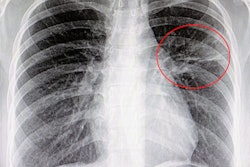
Experts suggest one reason digital x-ray is an attractive modality to researchers developing artificial intelligence (AI) models is that large patient datasets are more available than in other modalities. The chest radiographs used in data analysis for the studies we've highlighted in this Road to RSNA section alone number in the hundreds of thousands.
For instance, given the vast number of chest x-rays performed on patients so far during the COVID-19 pandemic, it's no surprise that digital x-ray is leading the way in the development of AI algorithms for diagnosing the disease. But researchers are now digging even deeper to find out whether AI models can detect racial and ethnic health disparities in COVID-19 chest radiography.
Digital x-ray is also proving central in work on AI applications in lung cancer, foot deformities, and tuberculosis, as well as in ways to improve surveillance following total hip arthroplasty procedures.
In addition, dual-energy x-ray absorptiometry (DEXA) appears primed for the application of AI, with researchers exploring whether deep learning can be used to obtain bone mineral density measurements from imaging. In another session, researchers suggest that a model they've developed for use in total-body DEXA imaging can identify body composition changes over time to predict all‐cause mortality.
From the perspective of medical physicists attending RSNA 2021, there's much that can be done to improve the basic functions of x-ray itself. We've highlighted one study presenting a new prototype of a low-dose, multicontrast chest x-ray system that eventually could be put to use for diagnosing and screening for lung cancer.
Plus, we've highlighted a few presentations in interventional radiology. In one, German researchers offer hard clinical evidence that transarterial chemoembolization with degradable starch microspheres is safe and effective for patients with unresectable hepatocellular carcinoma. In another session covering diversity, equity, and inclusion in radiology, researchers took a look at how many women are working in the vascular and interventional radiology field in the U.S. and found the rate is increasing second only to the rate in vascular surgery.
Ultimately, most people want to know when AI algorithms will be ready for prime time. Researchers appear aware of the issue. In one session we've included below, a team from the Henry Ford Health System in Michigan suggests it may be a while. The group will present evidence that AI algorithms don't hold up when applied to external datasets.
Keep reading for highlights of these and other digital x-ray presentations and posters scheduled for this year's meeting. You can also view the complete 2021 scientific and educational program on the RSNA website.



















